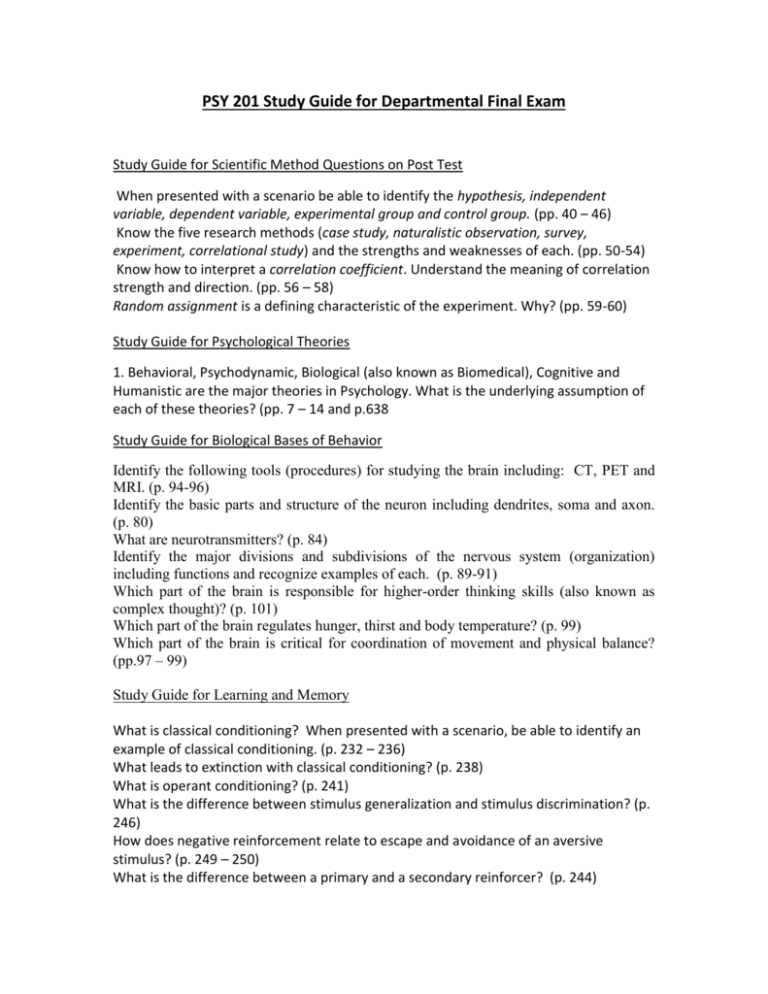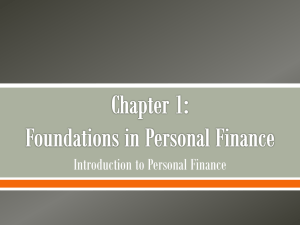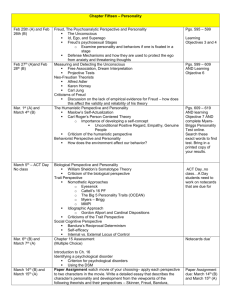PSY 201- General Psychology Study Guide for Departmental Final
advertisement

PSY 201 Study Guide for Departmental Final Exam Study Guide for Scientific Method Questions on Post Test When presented with a scenario be able to identify the hypothesis, independent variable, dependent variable, experimental group and control group. (pp. 40 – 46) Know the five research methods (case study, naturalistic observation, survey, experiment, correlational study) and the strengths and weaknesses of each. (pp. 50-54) Know how to interpret a correlation coefficient. Understand the meaning of correlation strength and direction. (pp. 56 – 58) Random assignment is a defining characteristic of the experiment. Why? (pp. 59-60) Study Guide for Psychological Theories 1. Behavioral, Psychodynamic, Biological (also known as Biomedical), Cognitive and Humanistic are the major theories in Psychology. What is the underlying assumption of each of these theories? (pp. 7 – 14 and p.638 Study Guide for Biological Bases of Behavior Identify the following tools (procedures) for studying the brain including: CT, PET and MRI. (p. 94-96) Identify the basic parts and structure of the neuron including dendrites, soma and axon. (p. 80) What are neurotransmitters? (p. 84) Identify the major divisions and subdivisions of the nervous system (organization) including functions and recognize examples of each. (p. 89-91) Which part of the brain is responsible for higher-order thinking skills (also known as complex thought)? (p. 101) Which part of the brain regulates hunger, thirst and body temperature? (p. 99) Which part of the brain is critical for coordination of movement and physical balance? (pp.97 – 99) Study Guide for Learning and Memory What is classical conditioning? When presented with a scenario, be able to identify an example of classical conditioning. (p. 232 – 236) What leads to extinction with classical conditioning? (p. 238) What is operant conditioning? (p. 241) What is the difference between stimulus generalization and stimulus discrimination? (p. 246) How does negative reinforcement relate to escape and avoidance of an aversive stimulus? (p. 249 – 250) What is the difference between a primary and a secondary reinforcer? (p. 244) What is observational learning? When presented with a scenario, be able to identify an example of observational learning. (p. 259 – 261) Differentiate between procedural and episodic memories. (p. 305) Differentiate between sensory, short-term, and long-term memory. (p. 280 – 285) What is chunking with regard to memory? (p. 283) Study Guide for Human Growth and Development Questions on What is the focus of Human Growth and Development? (p. 440) What are the stages of Erikson’s Psychosocial Development theory, and at what ages does each particular stage occur? What is the focus of Piaget’s stage theory? (pp. 451 – 457) How are moral decisions made (deciding whether an action is right or wrong) at the different levels of Kohlberg’s Moral Reasoning stages? (pp. 460 -462) What normal age-related changes are seen in the cognitive abilities of older adults? (pp. 473- 474) What is the important cognitive development that occurs during Piaget’s Sensorimotor stage? (p. 454) Study Guide for Abnormal Psychology and The Treatment of Mental Disorder What are the key symptoms of each of the anxiety disorders, mood disorders and schizophrenia? (pgs. 582-585, 590-599, 608) How does each of the major psychological approaches (psychoanalytic, behavioral, cognitive and humanistic) explain or attempt to treat abnormal behavior and mental illness? (pgs. 595-596, 585-586, 633-637) Distinguish between obsessive compulsive personality disorder, borderline personality disorder and antisocial personality disorder. (pgs. 604-606) What are the three key signs that behavior is “abnormal”? (pgs. 577-578) What is the DSM-IV and what is it used for? (pgs. 579-581) What do most drug therapies used to treat psychological disorders do in the brain? (pgs. 638-642) How do psychotherapy and drug therapies compare in effectiveness and relapse when used to treat psychological disorders? (pgs. 632, 637, 641-642) Which area of Applied Psychology focuses on diagnosis (also known as “assessment”) and treatment of mental disorders? (p. 624) Study Guide for Personality Development Questions on What is the focus of Maslow’s Humanistic theory of development? (pp. 510 – 513) What are the characteristics of the personality traits of The Five-factor theory of personality? (pp. 491 – 493) How does a Projective Personality Test assess personality, and what are examples of the two types of personality tests? (pp. 526- 527) According to the Social-Cognitive Theory of Personality, how does personality develop? (p. 504) What are the three components of Freud’s Psychodynamic Theory of Personality, and on what principle does each component operate? Pp. 493 – 494) Study Guide for Test Construction and Administration Questions What assessment tools are available to measure personality? (pp. 524 – 527) What are the characteristics of a well-designed psychological test? (pp. 356-359) Know the difference (i.e., what they measure) between an intelligence test, aptitude test, achievement test and personality test. (pp. 356 – 357)









